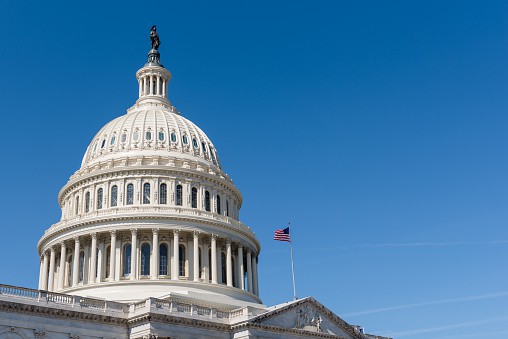What Manufacturers Need from Regulatory Reform

While smart regulations can enhance manufacturers’ competitiveness, there are far too many cases of unwieldy or unnecessary rules getting in their way. That’s why the NAM is standing up for regulatory reform and providing policymakers with a list of solutions to pursue today.
The challenge: The annual regulatory cost burden for an average U.S. firm represents 21% of its payroll, forcing manufacturers to divert resources away from important investments. For smaller manufacturers, the burden can be disproportionately painful, creating barriers to growth and development.
Our work: At the NAM, we’re advocating for a predictable regulatory agenda that is based on science and facts and that offers flexibility for innovation.
- The NAM’s agenda, contained in its policy blueprint Competing to Win, seeks to combat the fundamental problems in our outdated regulatory system.
- That includes ensuring that regulations focus on outcomes and rely on data; improving regulatory analysis; minimizing unnecessary burdens; strengthening industry outreach; preserving the ability of companies to grow; and reducing the abuse of our legal system.
What we’re saying: “Manufacturers in the United States should be able to grow, compete and win without being stymied by outdated and unnecessary regulations,” said NAM Director of Regulatory, Tax and Domestic Economic Policy Alex Monié.
- “We are proud of the work that the NAM has done to reduce the burden on businesses while also protecting the men and women who make things in America.”
- “We are committed to pressing forward so that every manufacturer can support their workforce, participate in market innovation, contribute to their communities, promote competitiveness and advance U.S. leadership.”
Learn more: Check out the NAM’s full regulatory reform agenda in Competing to Win—a strategic blueprint for the policies that manufacturers in America need to compete with the rest of the world.
Manufacturers’ Third Quarter Outlook Shows Continued Supply Chain Issues, Growing Workforce Needs and Rising Costs
Washington, D.C. – The National Association of Manufacturers released its Manufacturers’ Outlook Survey for the third quarter of 2022, which shows mixed results around a challenging economic environment, inflation, supply chains and the workforce. The NAM conducted the survey Aug. 16–30, 2022.
“Three out of four manufacturers still have a positive outlook for their businesses, but optimism has certainly declined. The majority of respondents are expecting a recession this year or next, and it’s clear the challenging environment is taking its toll. Manufacturers have shown incredible resilience through multiple crises, but the challenges of inflation, supply chain strains and the workforce shortage are taking a toll,” said NAM President and CEO Jay Timmons.
Key Findings:
- 78.3% of manufacturing leaders listed supply chain disruptions as a primary business challenge with only 10.8% believing improvement will occur by the end of the year.
- Attracting and retaining a quality workforce (76.1%), increased raw material costs (76.1%) and transportation and logistics costs (65.9%) were not far behind supply chain challenges as the biggest problems faced by manufacturers.
- More than three-quarters of manufacturers felt that rising material costs were a top business challenge (tied with workforce challenges and slightly below supply chain worries), and 40.4% said that inflationary pressures were worse today than six months ago. In addition, 53.7% noting that higher prices were making it harder to compete and remain profitable.
- The top sources of inflation were increased raw material prices (95.2%), freight and transportation costs (85.4%), wages and salaries (81.7%), energy costs (54.4%) and health care and other benefits costs (49.0%), with 21% also citing the war in Ukraine and global instability.
- When asked about what aspects of the CHIPS and Science Act were most important for supporting manufacturing activity, 69.6% of respondents cited strengthening U.S. leadership in energy innovation and competitiveness.
“This is a clear indication that we need urgent action to beat back the macroeconomic problems that are causing headwinds and preventing manufacturers in the U.S. from their full potential. Our ‘Competing to Win’ agenda gives policymakers the roadmap for solutions manufacturers need now to make our industry more globally competitive and, in turn, to boost optimism and confidence.
“Federal policies alone won’t solve everything, which is why we will continue to be part of the solution—innovating ways to deliver for our customers and spearheading efforts like the NAM and The Manufacturing Institute’s Creators Wanted workforce campaign.”
Due to the consistent economic headwinds, manufacturers’ confidence has declined, with 75.6% of respondents having a positive outlook for their company, the lowest since Q4 2020.
Conducted by NAM Chief Economist Chad Moutray, the Manufacturers’ Outlook Survey has surveyed the association’s membership of 14,000 manufacturers of all sizes on a quarterly basis for the past 20 years to gain insight into their economic outlook, hiring and investment decisions and business concerns.
The NAM releases these results to the public each quarter. Further information on the survey is available here. Click here for more on “Competing to Win.”
-NAM-
The National Association of Manufacturers is the largest manufacturing association in the United States, representing small and large manufacturers in every industrial sector and in all 50 states. Manufacturing employs more than 12.8 million men and women, contributes $2.77 trillion to the U.S. economy annually and accounts for 58% of private-sector research and development. The NAM is the powerful voice of the manufacturing community and the leading advocate for a policy agenda that helps manufacturers compete in the global economy and create jobs across the United States. For more information about the NAM or to follow us on Twitter and Facebook, please visit www.nam.org.
NAM Competes to Win on Taxes

The NAM is leading the way forward on a range of policies to help boost innovation, opportunity and competitiveness for manufacturers in the United States—and that includes tax policies that ensure manufacturers can continue to compete and win.
The record: During tax reform, the NAM achieved its key priorities—a lower corporate income tax rate, a reduced tax burden on pass-through business income, the adoption of a modern territorial tax system, the retention of the R&D tax credit and the adoption of incentives for capital equipment purchases.
- Thanks to a more competitive tax code, manufacturers across America have been investing in jobs, facilities and their communities.
The road ahead: Of course, the NAM isn’t taking its eye off the ball. We are committed to protecting our gains and furthering progress—and that means ensuring the tax code continues to incentivize manufacturers’ ability to invest in innovation and growth. We’re focusing on three important tax priorities in the months ahead.
Research and development: On Jan. 1 of this year, a harmful tax change went into effect that makes R&D more expensive in the United States by requiring businesses to deduct their R&D expenses over a period of years.
- The NAM has been leading the charge to ensure the tax code continues to support innovation by allowing businesses to fully deduct their R&D expenses in the year in which they are incurred. Check out these company stories on the importance of tax policies that support R&D.
Interest deductibility: When manufacturers borrow funds to buy capital equipment, the interest they pay on those loans is tax deductible up to a certain limit. But a recent change in the tax law modified how that limit is calculated—shrinking the deduction, making debt financing more expensive and leaving less capital for job creation and investment.
- The U.S. is the only OECD country with such a strict interest limitation, so the NAM is working with members of both parties in Congress to reverse the new limit calculation and enhance manufacturers’ ability to compete. Read more about the NAM’s work on this provision here.
Full expensing: Under present law, manufacturers can deduct 100% of their investments in assets with long useful lives, supporting their ability to acquire vital equipment and strengthening their competitiveness. However, the ability to deduct 100% of these costs begins to phase down at the beginning of 2023 and is set to completely expire in 2027.
- The NAM is leading the business community in advocating for full expensing permanency, joining with members of Congress to support legislation that would create certainty for manufacturers. See how full expensing has benefited small manufacturers in the United States here.
The last word: “The NAM is fighting to protect manufacturers across the country,” said NAM Senior Director of Tax Policy David Eiselsberg. “Protecting R&D, interest deductibility and full expensing will provide the tax certainty necessary for manufacturers to continue to invest in jobs and growth.”
Learn more: Check out the NAM’s full tax agenda in “Competing to Win.”
Manufacturers Unveil Competitiveness Agenda Ahead of Midterm Elections
“Competing to Win” offers a path for bringing the country together around policies, shared values and a unified purpose
Washington, D.C. – Ahead of the midterm elections, the National Association of Manufacturers released its policy roadmap, “Competing to Win,” a comprehensive blueprint featuring immediate solutions for bolstering manufacturers’ competitiveness. It is also a roadmap for policymakers on the laws and regulations needed to strengthen the manufacturing industry in the months and years ahead.
With the country facing rising prices, snarled supply chains and geopolitical turmoil, manufacturers are outlining an actionable competitiveness agenda that Americans across the political spectrum can support. “Competing to Win” includes the policies manufacturers in America will need in place to continue driving the country forward.
“‘Competing to Win’ offers a path for bringing our country together around policies, shared values and a unified purpose,” said NAM President and CEO Jay Timmons. “The NAM is putting forward a plan filled with ideas that policymakers could pursue immediately, including solutions to urgent problems, such as energy security, immigration reform, supply chain disruptions, the ongoing workforce shortage and more. Manufacturers have shown incredible resilience through difficult times, employing more workers now than before the pandemic, but continued resilience is not guaranteed without the policies that are critical to the state of manufacturing in America.”
The NAM and its members will leverage “Competing to Win” to shape policy debates ahead of the midterm elections, in the remainder of the 117th Congress and at the start of the 118th Congress—including in direct engagement with lawmakers, for grassroots activity, across traditional and digital media and through events in key states and districts as we did following the initial rollout of the roadmap in 2016.
The document focuses on 12 areas of action, and all policies are rooted in the values that have made America exceptional and keep manufacturing strong: free enterprise, competitiveness, individual liberty and equal opportunity.
Learn more about how manufacturers are leading and about the industry’s competitiveness agenda at nam.org/competing-to-win.
-NAM-
The National Association of Manufacturers is the largest manufacturing association in the United States, representing small and large manufacturers in every industrial sector and in all 50 states. Manufacturing employs more than 12.8 million men and women, contributes $2.77 trillion to the U.S. economy annually and accounts for 58% of private-sector research and development. The NAM is the powerful voice of the manufacturing community and the leading advocate for a policy agenda that helps manufacturers compete in the global economy and create jobs across the United States. For more information about the NAM or to follow us on Twitter and Facebook, please visit www.nam.org
Congress Leans into Electoral Count Reform

Following the events of January 2021, the processes for counting electoral votes has received renewed attention—and some members of Congress are working together to fix it.
The background: The law that governs the counting of electoral votes following a presidential election, called the Electoral Count Act, was written in 1887.
- Over the course of more than a century, the law has remained the same, even as ambiguities have caused conflicts and upheavals—most notably after the 2020 election.
- In the past two years, a bipartisan group of U.S. senators, led by Sens. Joe Manchin (D-WV) and Susan Collins (R-ME), have come together to develop the Electoral Count Reform Act, which is intended to remove ambiguities around the counting of electoral votes.
The proposal: While the ECRA is still being drafted, a few key provisions have been discussed. For example:
- The ECRA would clarify that the vice president’s role in vote counting is ceremonial, and that he or she is not empowered to throw out or change any state’s electoral votes.
- The bill raises the threshold for members of Congress to object to a state’s slate of electoral votes.
- Certain versions of the bill contain provisions that would increase election security, including by increasing penalties against individuals who threaten election officials.
- The bill would make clear that state legislatures cannot override the popular vote in their states or throw a state’s electors to someone other than the candidate chosen by their voters.
- The bill would also clear up ambiguities about presidential transition funds, ensuring that these funds can be disbursed to both candidates in the event of a disputed election in order to prevent delays.
Where we are: The current proposal has 17 cosponsors and is bipartisan. It has been through a hearing in the Rules Committee in the Senate, and it seems likely that some form of the ECRA will be considered this fall.
Our take: “The National Association of Manufacturers supports a clear, secure democratic process that doesn’t confer any partisan advantage and reduces opportunities to exploit ambiguities in the law,” said NAM Chief Legal Officer Linda Kelly. “A stable democracy is good for manufacturers and good for the world. That’s something we can all agree upon.”
Manufacturing Offers Many Debt-Free Careers

The manufacturing industry has had more than 2.6 million job openings nationally in 2022 already—a workforce shortage that shows little signs of slowing. Meanwhile, half of all those available jobs don’t require a four-year college degree or the debt that goes with it.
This week, President Biden announced new measures providing student debt relief to many eligible Americans. Yet the manufacturing industry helps young people avoid this problem in the first place, while also offering them salaries far above the national average.
Manufacturing Institute President Carolyn Lee weighed in on the advantages available to young people looking to make a strong entry into the workforce, instead of suffering under debt that makes it more difficult to start a family, purchase a first home and achieve other major life milestones. Here’s what she had to say.
How it works: Manufacturers often offer short-term certifications or other training programs that allow people to jump into high-paying careers quickly and without debt, Lee explains.
- “There are multiple pathways to career opportunities in manufacturing through skills training, ranging from short-term programs to more involved skills development and apprenticeship programs,” says Lee.
- For example, the Federation for Advanced Manufacturing Education (FAME) program (founded by Toyota and operated by the MI) offers current and aspiring manufacturing workers both on-the-job training and classroom education. The program leads to an associate degree and an Advanced Manufacturing Technician (AMT) certificate.
- Manufacturers work with FAME’s local chapters in part because they allow companies to use a global best system to train the skilled workforce they need to compete.
The numbers: The data show that manufacturing is a good choice for those inclined to avoid debt, Lee points out.
- As noted above, there have been more than 2.6 million manufacturing job openings so far in 2022, but just 47% of those job openings (about 1.2 million) require a bachelor’s degree or greater.
- Meanwhile, manufacturing workers in 2020 earned $92,832 on average (compared to an average of $77,181 for workers in all private nonfarm industries).
What can policymakers do? To ensure that manufacturing training programs continue to expand and succeed, policymakers should make certain changes, says Lee.
- For example, Pell Grants should be usable for high-quality training programs as short as eight weeks—often all that is needed to train a technician.
- Policymakers should also ensure that our education system focuses on skills attainment for career success, and that teachers and other influencers are aware of opportunities offered by pathways other than four-year degree programs.
#CreatorsWanted: The NAM and the MI have taken this message to communities across the country through the Creators Wanted campaign’s tour and mobile experience. Tens of thousands of students, parents, educators and local leaders have attended the tour stops, where they learned about the promise of manufacturing careers and were challenged to think like manufacturers in the interactive mobile experience.
- As Lee told students at the Creators Wanted stop in Freeport, Texas, “Without a steady stream of talented, bright young people … we can’t keep up the good work of continuously making our products. This is not a get-one-job-and-stay-there-for-40-years [situation]. This is a choose-your-own-adventure [career path] with continuing skills and challenges and opportunities and learning along the way.”
The last word: “We understand how oppressive student debt can be, especially when starting out in life,” said Lee. “More people should be able to get a rewarding and well-paying job that doesn’t require massive debt that takes a lifetime to pay off. This is one of the reasons we work so hard to make sure young people know about the variety of options available to them in manufacturing careers; it’s not just for the industry’s benefit, but for theirs as well.”
If you’d like to hear more about careers in manufacturing, come to one of the many MFG Day events happening this October.
Every Manufacturer in America Will Benefit from the CHIPS and Science Act
Timmons: Manufacturers thank congressional leaders from both parties who got this bill across the finish line and President Biden and Secretary Raimon
Washington, D.C. – Following President Biden’s signing of the CHIPS and Science Act of 2022, National Association of Manufacturers President and CEO Jay Timmons released the following statement:
“Every manufacturer in America will benefit from the CHIPS and Science Act, whether they make chips, make products that require chips or are part of a supply chain disrupted by the semiconductor shortage.
“Manufacturers thank congressional leaders from both parties who got this bill across the finish line and President Biden and Secretary Raimondo for their leadership. The industry will also benefit from the new law’s funding for programs to support the STEM workforce, advanced technology development, excavation of critical minerals, clean energy and more.
“Without a doubt, this legislation boosts manufacturers’ competitiveness. But there’s work to be done. Congress must continue its work on China competition legislation and move forward on policies from the U.S. Innovation and Competition Act and the America COMPETES Act that were left out, such as anti-counterfeiting measures, important trade provisions and further investments in supply chain resilience and workforce development.
“Our economic future and America’s leadership in the world depend on a competitive manufacturing industry. Congress has acted wisely with the CHIPS and Science Act. Now we need Congress to continue standing with manufacturers and focus on policies that will help us compete with China and other countries, not make it more expensive to make things in America.”
-NAM-
The National Association of Manufacturers is the largest manufacturing association in the United States, representing small and large manufacturers in every industrial sector and in all 50 states. Manufacturing employs more than 12.8 million men and women, contributes $2.77 trillion to the U.S. economy annually and accounts for 58% of private-sector research and development. The NAM is the powerful voice of the manufacturing community and the leading advocate for a policy agenda that helps manufacturers compete in the global economy and create jobs across the United States. For more information about the NAM or to follow us on Twitter and Facebook, please visit www.nam.org.
Manufacturers Remain Staunchly Opposed to the Inflation Reduction Act
Timmons: These new taxes will still deliver a blow to our industry’s ability to raise wages, hire workers and invest in our communities
Washington, D.C. – Following the release of the text of the Inflation Reduction Act, NAM President and CEO Jay Timmons released the following statement:
“The NAM remains staunchly opposed to the IRA. It increases taxes on manufacturers in America, undermining our competitiveness while we are facing harsh economic headwinds such as supply chain disruptions and the highest rate of inflation in decades.
“We appreciate that the ‘book tax’ has been revised to reflect the importance of job-creating investments in machinery and equipment. But that is insufficient. These new taxes will still deliver a blow to our industry’s ability to raise wages, hire workers and invest in our communities. In addition, the proposed direct negotiations over prescription drugs are a form of price setting and antithetical to the open marketplace of the Medicare Part D program. Pursuing price control policies could threaten future innovation and cures.
“Any desirable elements of this bill can and should be pursued as standalone legislation. As a whole, the bill simply does not position our industry or our country for future growth or global economic leadership and competitiveness, so we urge all lawmakers to stand with us and reject it.”
-NAM-
The National Association of Manufacturers is the largest manufacturing association in the United States, representing small and large manufacturers in every industrial sector and in all 50 states. Manufacturing employs more than 12.8 million men and women, contributes $2.77 trillion to the U.S. economy annually and accounts for 58% of private-sector research and development. The NAM is the powerful voice of the manufacturing community and the leading advocate for a policy agenda that helps manufacturers compete in the global economy and create jobs across the United States. For more information about the NAM or to follow us on Twitter and Facebook, please visit www.nam.org.
Manufacturing Voters Oppose Corporate Minimum Tax

The vast majority of manufacturing voters in Arizona disapprove of the U.S. Senate’s proposal to impose a “corporate minimum tax,” according to the results of a joint NAM–Arizona Chamber of Commerce & Industry snap poll yesterday.
The results: More than 90% of the manufacturing voters polled are against the tax, while 91% said it would harm manufacturers’ ability to invest in their businesses, upgrade facilities and buy new machinery.
- Respondents also said the measure would put both manufacturing jobs and the U.S. economy in jeopardy.
The NAM’s view: “With the U.S. and Arizona economies already showing signs of weakening, this is the wrong time to further undermine growth and the manufacturing sector’s overall competitiveness,” NAM Chief Economist Chad Moutray said.
- Moutray cited analyses by the nonpartisan Joint Committee on Taxation and the NAM that found the tax would disproportionately harm manufacturers.
- This tax “will make it harder to hire more workers, raise wages and invest in our communities,” Moutray continued. “Arizona’s manufacturing voters are clearly saying that this tax will hurt our economy.”
The Arizona Chamber says: “In the face of record-high inflation, supply chain backlogs and a major labor crunch, now is not the time to hammer manufacturers with new taxes,” Arizona Chamber of Commerce & Industry President and CEO Danny Seiden said.
- “Arizona job creators will continue to urge lawmakers to reject this manufacturers tax and instead focus on policies that encourage job growth and strengthen our state and national economic competitiveness.”
NEW: Arizona Snap Poll Shows Manufacturing Voters Strongly Oppose Reconciliation Tax
Washington, D.C. – The National Association of Manufacturers and Arizona Chamber of Commerce & Industry released a new snap poll today showing that an overwhelming majority of manufacturing voters in Arizona disapprove of the U.S. Senate’s plan to raise taxes on manufacturers. More than 90% of manufacturing voters opposed the tax, while 91% agreed that the tax would harm manufacturers’ ability to invest in their business, buy new machinery and upgrade facilities and put manufacturing jobs and economic recovery at risk.
“With the U.S. and Arizona economy already showing signs of weakening, this is the wrong time to further undermine growth and the manufacturing sector’s overall competitiveness. As the nonpartisan Joint Committee on Taxation analysis has shown, the corporate minimum tax is disproportionately focused on manufacturers and will limit the sector’s ability to grow and invest—in Arizona and across the country,” said NAM Chief Economist Chad Moutray. “As the survey shows and as other data indicate, it will make it harder to hire more workers, raise wages and invest in our communities. Arizona’s manufacturing voters are clearly saying that this tax will hurt our economy.”
According to recent analyses by the Joint Committee on Taxation and the NAM, the “corporate minimum tax” currently under consideration in the U.S. Senate will largely fall on the backs of manufacturers, cost almost 220,000 jobs and reduce GDP by nearly $70 billion, while reducing labor income by over $17 billion in 2023 alone.
“Arizona job creators will continue to urge lawmakers to reject this manufacturers tax and instead focus on policies that encourage job growth and strengthen our state and national economic competitiveness,” Arizona Chamber of Commerce & Industry President and CEO Danny Seiden said. “In the face of record-high inflation, supply chain backlogs and a major labor crunch, now is not the time to hammer manufacturers with new taxes.”
Background/Methodology:
Conducted by the NAM analytics team, this snap poll collected 223 responses from a statewide sample of Arizona manufacturing workers, managers and advocates. In total, 80% of the responses came via SMS text to web and 20% came via email.
-NAM-
The National Association of Manufacturers is the largest manufacturing association in the United States, representing small and large manufacturers in every industrial sector and in all 50 states. Manufacturing employs more than 12.8 million men and women, contributes $2.77 trillion to the U.S. economy annually and accounts for 58% of private-sector research and development. The NAM is the powerful voice of the manufacturing community and the leading advocate for a policy agenda that helps manufacturers compete in the global economy and create jobs across the United States. For more information about the NAM or to follow us on Twitter and Facebook, please visit www.nam.org.
